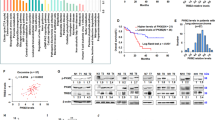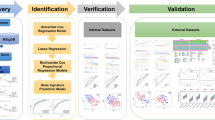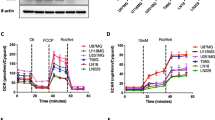Abstract
Aerobic glycolysis or the Warburg effect contributes to cancer cell proliferation; however, how this glucose metabolism pathway is precisely regulated remains elusive. Here we show that receptor-interacting protein 1 (RIP1), a cell death and survival signaling factor, regulates mitochondrial oxidative phosphorylation and aerobic glycolysis. Loss of RIP1 in lung cancer cells suppressed peroxisome proliferator-activated receptor γ coactivator-1α (PGC-1α) expression, impairing mitochondrial oxidative phosphorylation and accelerating glycolysis, resulting in spontaneous DNA damage and p53-mediated cell proliferation inhibition. Thus, although aerobic glycolysis within a certain range favors cancer cell proliferation, excessive glycolysis causes cytostasis. Our data suggest that maintenance of glycolysis by RIP1 is pivotal to cancer cell energy homeostasis and DNA integrity and may be exploited for use in anticancer therapy.
Similar content being viewed by others
Log in or create a free account to read this content
Gain free access to this article, as well as selected content from this journal and more on nature.com
or
Abbreviations
- ATM:
-
ataxia telangiectasia mutated
- ATR:
-
ataxia telangiectasia and Rad3 related
- BPDE:
-
benzo[a]pyrene diol epoxide
- CHK:
-
checkpoint kinase
- COX:
-
cytochrome c oxidase
- cyt c:
-
cytochrome c
- 2-DG:
-
2-deoxy-D-glucose
- GAPDH:
-
glyceraldehyde phosphate dehydrogenase
- H2AX:
-
H2A histone family, member X
- LDH:
-
lactate dehydrogenase
- MDM2:
-
mouse double minute 2 homolog
- MnSOD:
-
manganese superoxide dismutase
- NAC:
-
N-acetyl cysteine
- NAD+:
-
nicotinamide adenine dinucleotide
- NF-κB:
-
nuclear factor-kappa B
- PGC-1α:
-
peroxisome proliferator-activated receptor-gamma coactivator 1α
- PARP:
-
poly (ADP-ribose) polymerase
- PI3K:
-
phosphatidylinositide 3-kinase
- OXPHOS:
-
oxidative phosphorylation
- RIP1:
-
receptor-interacting protein 1
- ROS:
-
reactive oxygen species
- TNFα:
-
tumor necrosis factor α
References
Warburg O . On the origin of cancer cells. Science 1956; 123: 309–314.
Seyfried TN, Shelton LM . Cancer as a metabolic disease. Nutr Metab 2010; 7: 7.
Zhang WC, Shyh-Chang N, Yang H, Rai A, Umashankar S, Ma S et al. Glycine decarboxylase activity drives non-small cell lung cancer tumor-initiating cells and tumorigenesis. Cell 2012; 148: 259–272.
Sebastian C, Zwaans BM, Silberman DM, Gymrek M, Goren A, Zhong L et al. The histone deacetylase SIRT6 is a tumor suppressor that controls cancer metabolism. Cell 2012; 151: 1185–1199.
Cairns RA, Harris IS, Mak TW . Regulation of cancer cell metabolism. Nat Rev 2011; 11: 85–95.
Ward PS, Thompson CB . Metabolic reprogramming: a cancer hallmark even warburg did not anticipate. Cancer Cell 2012; 21: 297–308.
Levine AJ, Puzio-Kuter AM . The control of the metabolic switch in cancers by oncogenes and tumor suppressor genes. Science 2010; 330: 1340–1344.
Dang CV . Links between metabolism and cancer. Gene Dev 2012; 26: 877–890.
Vandenabeele P, Galluzzi L, Vanden Berghe T, Kroemer G . Molecular mechanisms of necroptosis: an ordered cellular explosion. Nat Rev Mol Cell Biol 2010; 11: 700–714.
Park S, Ramnarain DB, Hatanpaa KJ, Mickey BE, Saha D, Paulmurugan R et al. The death domain-containing kinase RIP1 regulates p27(Kip1) levels through the PI3K-Akt-forkhead pathway. EMBO Rep 2008; 9: 766–773.
Lin Y, Yang Q, Wang X, Liu ZG . The essential role of the death domain kinase receptor-interacting protein in insulin growth factor-I-induced c-Jun N-terminal kinase activation. J Biol Chem 2006; 281: 23525–23532.
Declercq W, Vanden Berghe T, Vandenabeele P . RIP kinases at the crossroads of cell death and survival. Cell 2009; 138: 229–232.
Temkin V, Huang Q, Liu H, Osada H, Pope RM . Inhibition of ADP/ATP exchange in receptor-interacting protein-mediated necrosis. Mol Cell Biol 2006; 26: 2215–2225.
Kasof GM, Prosser JC, Liu D, Lorenzi MV, Gomes BC . The RIP-like kinase, RIP3, induces apoptosis and NF-kappaB nuclear translocation and localizes to mitochondria. FEBS Lett 2000; 473: 285–291.
Wang Z, Jiang H, Chen S, Du F, Wang X . The mitochondrial phosphatase PGAM5 functions at the convergence point of multiple necrotic death pathways. Cell 2012; 148: 228–243.
Zhang DW, Shao J, Lin J, Zhang N, Lu BJ, Lin SC et al. RIP3, an energy metabolism regulator that switches TNF-induced cell death from apoptosis to necrosis. Science 2009; 325: 332–336.
Park S, Hatanpaa KJ, Xie Y, Mickey BE, Madden CJ, Raisanen JM et al. The receptor interacting protein 1 inhibits p53 induction through NF-kappaB activation and confers a worse prognosis in glioblastoma. Cancer Res 2009; 69: 2809–2816.
Roth J, Koch P, Contente A, Dobbelstein M . Tumor-derived mutations within the DNA-binding domain of p53 that phenotypically resemble the deletion of the proline-rich domain. Oncogene 2000; 19: 1834–1842.
Reinhardt HC, Schumacher B . The p53 network: cellular and systemic DNA damage responses in aging and cancer. Trends Genet 2012; 28: 128–136.
Burma S, Chen BP, Murphy M, Kurimasa A, Chen DJ . ATM phosphorylates histone H2AX in response to DNA double-strand breaks. J Biol Chem 2001; 276: 42462–42467.
Mah LJ, El-Osta A, Karagiannis TC . gammaH2AX: a sensitive molecular marker of DNA damage and repair. Leukemia 2010; 24: 679–686.
Sarkaria JN, Busby EC, Tibbetts RS, Roos P, Taya Y, Karnitz LM et al. Inhibition of ATM and ATR kinase activities by the radiosensitizing agent, caffeine. Cancer Res 1999; 59: 4375–4382.
Ciccia A, Elledge SJ . The DNA damage response: making it safe to play with knives. Mol Cell 2010; 40: 179–204.
Wang L, Du F, Wang X . TNF-alpha induces two distinct caspase-8 activation pathways. Cell 2008; 133: 693–703.
Wu M, Neilson A, Swift AL, Moran R, Tamagnine J, Parslow D et al. Multiparameter metabolic analysis reveals a close link between attenuated mitochondrial bioenergetic function and enhanced glycolysis dependency in human tumor cells. Am J Physiol Cell Physiol 2007; 292: C125–C136.
Surjana D, Halliday GM, Damian DL . Role of nicotinamide in DNA damage, mutagenesis, and DNA repair. J Nucleic Acids 2010; 2010: 157591.
Belenky P, Bogan KL, Brenner C . NAD+ metabolism in health and disease. Trends Biochem Sci 2007; 32: 12–19.
Lim JH, Lee YM, Chun YS, Chen J, Kim JE, Park JW . Sirtuin 1 modulates cellular responses to hypoxia by deacetylating hypoxia-inducible factor 1alpha. Mol Cell 2010; 38: 864–878.
DeBerardinis RJ, Lum JJ, Hatzivassiliou G, Thompson CB . The biology of cancer: metabolic reprogramming fuels cell growth and proliferation. Cell Metab 2008; 7: 11–20.
Borniquel S, Garcia-Quintans N, Valle I, Olmos Y, Wild B, Martinez-Granero F et al. Inactivation of Foxo3a and subsequent downregulation of PGC-1 alpha mediate nitric oxide-induced endothelial cell migration. Mol Cell Biol 2010; 30: 4035–4044.
Sahin E, Colla S, Liesa M, Moslehi J, Muller FL, Guo M et al. Telomere dysfunction induces metabolic and mitochondrial compromise. Nature 2011; 470: 359–365.
Wu Z, Puigserver P, Andersson U, Zhang C, Adelmant G, Mootha V et al. Mechanisms controlling mitochondrial biogenesis and respiration through the thermogenic coactivator PGC-1. Cell 1999; 98: 115–124.
Lin J, Handschin C, Spiegelman BM . Metabolic control through the PGC-1 family of transcription coactivators. Cell Metab 2005; 1: 361–370.
Giguere V . Transcriptional control of energy homeostasis by the estrogen-related receptors. Endocrine Rev 2008; 29: 677–696.
Kelly DP, Scarpulla RC . Transcriptional regulatory circuits controlling mitochondrial biogenesis and function. Gene Dev 2004; 18: 357–368.
Robinson BH, Petrova-Benedict R, Buncic JR, Wallace DC . Nonviability of cells with oxidative defects in galactose medium: a screening test for affected patient fibroblasts. Biochem Med Metab Biol 1992; 48: 122–126.
Handschin C . The biology of PGC-1alpha and its therapeutic potential. Trends Pharmacol Sci 2009; 30: 322–329.
Girnun GD . The diverse role of the PPARgamma coactivator 1 family of transcriptional coactivators in cancer. Semin Cell Dev Biol 2012; 23: 381–388.
Fernandez-Marcos PJ, Auwerx J . Regulation of PGC-1alpha, a nodal regulator of mitochondrial biogenesis. Am J Clin Nutr 2011; 93: 884S–890S.
Janssens S, Tinel A, Lippens S, Tschopp J . PIDD mediates NF-kappaB activation in response to DNA damage. Cell 2005; 123: 1079–1092.
Dengler MA, Staiger AM, Gutekunst M, Hofmann U, Doszczak M, Scheurich P et al. Oncogenic stress induced by acute hyper-activation of Bcr-Abl leads to cell death upon induction of excessive aerobic glycolysis. PLoS One 2011; 6: e25139.
Birnboim HC, Kanabus-Kaminska M . The production of DNA strand breaks in human leukocytes by superoxide anion may involve a metabolic process. Proc Natl Acad Sci USA 1985; 82: 6820–6824.
Tanaka T, Kurose A, Halicka HD, Traganos F, Darzynkiewicz Z . 2-deoxy-D-glucose reduces the level of constitutive activation of ATM and phosphorylation of histone H2AX. Cell Cycle 2006; 5: 878–882.
Jain VK, Kalia VK, Sharma R, Maharajan V, Menon M . Effects of 2-deoxy-D-glucose on glycolysis, proliferation kinetics and radiation response of human cancer cells. Int J Radiat Oncol Biol Phys 1985; 11: 943–950.
Dwarkanath BS, Zolzer F, Chandana S, Bauch T, Adhikari JS, Muller WU et al. Heterogeneity in 2-deoxy-D-glucose-induced modifications in energetics and radiation responses of human tumor cell lines. Int J Radiat Oncol Biol Phys 2001; 50: 1051–1061.
Chiarugi A, Dolle C, Felici R, Ziegler M . The NAD metabolome—a key determinant of cancer cell biology. Nat Rev 2012; 12: 741–752.
Wang X, Ju W, Renouard J, Aden J, Belinsky SA, Lin Y . 17-allylamino-17-demethoxygeldanamycin synergistically potentiates tumor necrosis factor-induced lung cancer cell death by blocking the nuclear factor-kappaB pathway. Cancer Res 2006; 66: 1089–1095.
Wang P, Zhang J, Bellail A, Jiang W, Hugh J, Kneteman NM et al. Inhibition of RIP and c-FLIP enhances TRAIL-induced apoptosis in pancreatic cancer cells. Cell signalling 2007; 19: 2237–2246.
Hur GM, Lewis J, Yang Q, Lin Y, Nakano H, Nedospasov S et al. The death domain kinase RIP has an essential role in DNA damage-induced NF-kappa B activation. Gene Dev 2003; 17: 873–882.
Vanlangenakker N, Vanden Berghe T, Vandenabeele P . Many stimuli pull the necrotic trigger, an overview. Cell Death Differ 2012; 19: 75–86.
Biton S, Ashkenazi A . NEMO and RIP1 control cell fate in response to extensive DNA damage via TNF-alpha feedforward signaling. Cell 2011; 145: 92–103.
Zong WX, Ditsworth D, Bauer DE, Wang ZQ, Thompson CB . Alkylating DNA damage stimulates a regulated form of necrotic cell death. Gene Dev 2004; 18: 1272–1282.
Lin Y, Devin A, Rodriguez Y, Liu ZG . Cleavage of the death domain kinase RIP by caspase-8 prompts TNF-induced apoptosis. Genes Dev 1999; 13: 2514–2526.
Puigserver P, Wu Z, Park CW, Graves R, Wright M, Spiegelman BM . A cold-inducible coactivator of nuclear receptors linked to adaptive thermogenesis. Cell 1998; 92: 829–839.
Daitoku H, Yamagata K, Matsuzaki H, Hatta M, Fukamizu A . Regulation of PGC-1 promoter activity by protein kinase B and the forkhead transcription factor FKHR. Diabetes 2003; 52: 642–649.
Karamanlidis G, Bautista-Hernandez V, Fynn-Thompson F, Del Nido P, Tian R . Impaired mitochondrial biogenesis precedes heart failure in right ventricular hypertrophy in congenital heart disease. Circ Heart Fail 2011; 4: 707–713.
Acknowledgements
We thank Dr. Akiyoshi Fukamizu (University of Tsukuba, Japan) for providing the human PGC-1 promoter luciferase construct and Dr. Bruce M. Spiegelman (Harvard Medical School) for the deposit of PGC-1 expressing plasmid to Addgene. We are grateful to Tamara Howard, MS, Department of Cell Biology and Physiology, University of New Mexico, for help in experiments. This work was partially supported by NIH grants R01ES017328 (Y.L.) and R03CA167727 (W.C.), and a grant (DE-FG02-09ER64783) from Low Dose Radiation Program, U.S. Department of Energy (Y.L).
Author information
Authors and Affiliations
Corresponding author
Ethics declarations
Competing interests
The authors declare no conflict of interest.
Additional information
Edited by G Melino
Supplementary Information accompanies this paper on Cell Death and Differentiation website
Supplementary information
Rights and permissions
About this article
Cite this article
Chen, W., Wang, Q., Bai, L. et al. RIP1 maintains DNA integrity and cell proliferation by regulating PGC-1α-mediated mitochondrial oxidative phosphorylation and glycolysis. Cell Death Differ 21, 1061–1070 (2014). https://doi.org/10.1038/cdd.2014.25
Received:
Revised:
Accepted:
Published:
Issue date:
DOI: https://doi.org/10.1038/cdd.2014.25
Keywords
This article is cited by
-
RIP1 promotes proliferation through G2/M checkpoint progression and mediates cisplatin-induced apoptosis and necroptosis in human ovarian cancer cells
Acta Pharmacologica Sinica (2020)
-
miR-23b-3p suppressing PGC1α promotes proliferation through reprogramming metabolism in osteosarcoma
Cell Death & Disease (2019)
-
Metabolic reprogramming during neuronal differentiation
Cell Death & Differentiation (2016)
-
Leptin-induced mitochondrial fusion mediates hepatic lipid accumulation
International Journal of Obesity (2015)
-
Cell death controlling complexes and their potential therapeutic role
Cellular and Molecular Life Sciences (2015)



